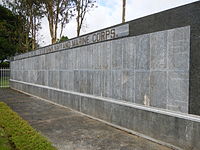
Raid at Cabanatuan
The Raid at Cabanatuan (Filipino: Pagsalakay sa Cabanatuan), also known as the Great Raid (Filipino: Ang Dakilang Pagsalakay), was a rescue of Allied prisoners of war (POWs) and civilians from a Japanese camp near Cabanatuan, Nueva Ecija, Philippines. On January 30, 1945, during World War II, United States Army Rangers, Alamo Scouts and Filipino guerrillas attacked the camp and liberated more than 500 prisoners.
After the surrender of tens of thousands of American troops during the Battle of Bataan, many were sent to the Cabanatuan prison camp after the Bataan Death March. The Japanese shifted most of the prisoners to other areas, leaving just over 500 American and other Allied POWs and civilians in the prison. Facing brutal conditions including disease, torture, and malnourishment, the prisoners feared they would be executed by their captors before the arrival of General Douglas MacArthur and his American forces returning to Luzon. In late January 1945, a plan was developed by Sixth Army leaders and Filipino guerrillas to send a small force to rescue the prisoners. A group of over 100 Rangers and Scouts and 200 guerrillas traveled 30 miles (48 km) behind Japanese lines to reach the camp.
In a nighttime raid, under the cover of darkness and with distraction by a P-61 Black Widow night fighter, the group surprised the Japanese forces in and around the camp. Hundreds of Japanese troops were killed in the 30-minute coordinated attack; the Americans suffered minimal casualties. The Rangers, Scouts, and guerrillas escorted the POWs back to American lines. The rescue allowed the prisoners to tell of the death march and prison camp atrocities, which sparked a rush of resolve for the war against Japan. The rescuers were awarded commendations by MacArthur, and were also recognized by President Franklin D. Roosevelt. A memorial now sits on the site of the former camp, and the events of the raid have been depicted in several films.







